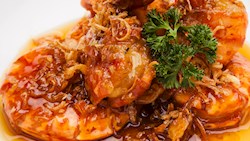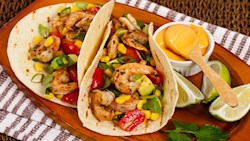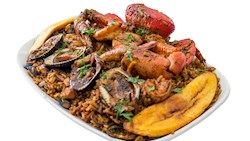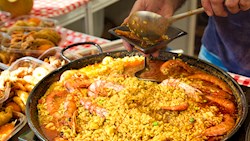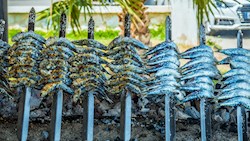MAIN INGREDIENTS
Loimulohi is a traditional method of preparing salmon or rainbow trout. The fish is smoked on a wooden plank that's placed vertically over an open fire. Before the process, the salmon is usually seasoned with sea salt and drizzled or brushed with lemon juice, honey, or juniper berries.
The cooking time depends on the distance from the coals. Once done, the smoky fish can be eaten straight off the plank.
One of the most popular fresh seafood one-bowl donburi dishes, kaisendon consists of thinly sliced, assorted raw seafood called sashimi laid over freshly steamed rice. What kind of sashimi will be used in a kaisendon dish is not fixed, but the seafood selection depends on both location and season, and most often includes maguro (tuna), tai (sea bream), ama ebi (deep-water shrimps), hotate (scallops), uni (sea urchin), kani (crab), and sometimes even marinated ikura (salmon roe).
Apart from sashimi, kaisendon is typically topped with toasted nori seaweed, myoga ginger, shiso or Japanese basil, cucumber, onions, and either fresh or pickled ginger. Before being placed on a bed of steamy rice, all of the ingredients are drizzled with wasabi-laced soy sauce, and the kaisendon bowl is lastly garnished with some white sesame seeds, white radish sprouts, and wasabi paste.
MOST ICONIC Kaisendon
View moreUnadon is a Japanese dish consisting of grilled unagi (eel) fillets placed on top of steamed rice. The eel is grilled kabayaki-style, where the fish is split, gutted, butterflied, cut into squares, skewered, then diped in tare sauce before being grilled.
The tare sauce consists of soy sauce, mirin, sugar, and sake. It provides the necessary caramelization to the fish during the grilling process. Before serving, unadon is typically garnished with sanshō berries on top. In Kantō, the eel is traditionally steamed before grilling, resulting in a more tender texture of the fish, while in Kansai, the eel is simply grilled without prior steaming.
Chả cá Lã Vọng is a traditional dish originating from Hanoi. It consists of grilled fish with turmeric and dill. In order to prepare it, firm white fish such as catfish, cod, or tilapia is usually marinated in shallots, galangal, turmeric, garlic, shrimp paste, fish sauce, and oil.
It is then grilled on both sides with dill and spring onions and served with vermicelli noodles, roasted peanuts, and a dipping sauce consisting of lime juice, garlic, fish sauce, and sugar. This dish dates back to the French Indochina days of Vietnam, and the resistance fighters used to meet in the Old Quarter of Hanoi.
MAIN INGREDIENTS
Chutoro nigiri sushi is a traditional type of nigiri sushi. It consists of hand-pressed sushi rice that's topped with slices of medium-fatty cuts of tuna. Different cuts of tuna are classified as otoro (fatty), chutoro (medium-fatty), and akami (red meat).
The dish has a rich and deep flavor and a soft texture. Traditionally, this type of sushi is eaten by hand in a single bite. It's usually accompanied by soy sauce, wasabi, or pickled ginger (gari) on the side.
MOST ICONIC Chutoro nigiri sushi
View moreMAIN INGREDIENTS
A quintessential seafood delicacy of the Greek island of Symi, simiako garidaki or Symi shrimp is a unique variety of tiny shrimps that inhabit the sea around the island. Bright red, delicate, and sweet, the small crustaceans are packed with flavor, which has made them famous throughout the whole country and beyond.
The most common way to enjoy these tiny crustaceans is crispy-fried in olive oil and garlic, typically seasoned with nothing else than salt and pepper. Due to their delicate nature, the fried shrimps are usually eaten whole, including tails, shells, and heads.
MAIN INGREDIENTS
Camarones enchipotlados is a traditional dish originating from Central Mexico. Although there are many variations, the dish is usually made with a combination of shrimps, tomatoes, olive oil, chipotle chiles, ginger, garlic, orange juice and zest, salt, and pepper.
The tomatoes are halved, seasoned with salt and pepper, brushed with olive oil, and roasted in the oven. The shrimps are marinated in a mixture of tomatoes, hot peppers, and ginger. Orange zest and juice, garlic, and ginger are fried in olive oil and simmered for a few minutes.
Vieiras en su concha is a traditional dish originating from Galicia, consisting of scallops served in their shells. The dish is usually made with a combination of scallops, olive oil, onions, garlic, pimentón, white wine, tomato sauce, salt, pepper, breadcrumbs, and parsley.
The garlic, onions, and pimentón are sautéed in olive oil, then covered with wine, tomato sauce, and seasonings in order to create a sauce. The scallops are boiled and arranged on a baking sheet in their shells, then topped with the tomato mixture, breadcrumbs, and parsley.
MAIN INGREDIENTS
Ceviche is the national dish of Peru consisting of slices of raw fish or shellfish that is spiced with salt, onions, and chili peppers, then marinated in lime juice. Due to the acidity of lime juice, the texture of the fish changes, as does its color – from pink to white.
The acidic marinade, also known as leche de tigre (lit. tiger's milk) "cooks" the meat without any heat involved in the process. For ceviche, fresh fish is an imperative, as fish and shellfish that are not fresh can cause food poisoning. Peruvians are used to fresh ingredients, so the fish will sometimes be prepared for ceviche less than an hour after being caught.
VARIATIONS OF Ceviche
MOST ICONIC Ceviche
View moreNigiri or nigirizushi is a special kind of hand-pressed sushi where the meat is sliced and pressed on top of sushi rice. It was developed in Tokyo (then called Edo) during the 1800s. Sometimes, nori seaweed is used to wrap the whole concoction and keep it together.
The topping is usually seafood such as shrimp, tuna, haddock, or eel, and it should always be fresh and of the highest quality. Traditionally, nigirizushi is paired with shiso leaves, wasabi, soy sauce, or pickled ginger. It is sometimes garnished with daikon and salted seaweed.
VARIATIONS OF Nigiri
MOST ICONIC Nigiri
View moreTasteAtlas food rankings are based on the ratings of the TasteAtlas audience, with a series of mechanisms that recognize real users and that ignore bot, nationalist or local patriotic ratings, and give additional value to the ratings of users that the system recognizes as knowledgeable. For the “Top 100 Seafood Dishes in the World” list until February 13, 2025, 32,596 ratings were recorded, of which 21,899 were recognized by the system as legitimate. TasteAtlas Rankings should not be seen as the final global conclusion about food. Their purpose is to promote excellent local foods, instill pride in traditional dishes, and arouse curiosity about dishes you haven’t tried.




































